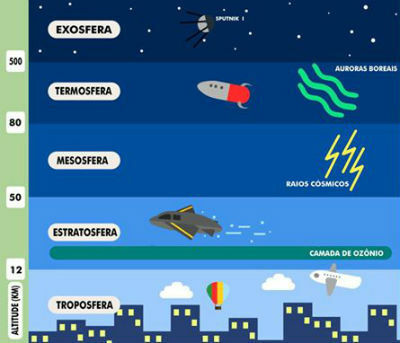Atmosphere is the layer of air that surrounds our planet. Other planets in the solar system also have an atmosphere.
The gases that make up the atmosphere are held around the Earth due to the pull of gravity and follow its movement.
The density of air decreases as we increase altitude, with 50% of the suspended gases and particles located in the first 5 km.
The atmosphere is fundamental to the maintenance of life on Earth because:
- It is a source of oxygen, an essential gas for life.
- Regulates the Earth's temperature and climate.
- It is responsible for the distribution of water on the planet (rain).
- Protect the Earth from cosmic radiation and meteors.
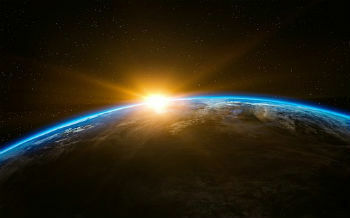
Atmosphere: our protective shield.
Earth Atmosphere
The Earth's atmosphere has different characteristics along its vertical profile and its thickness is approximately 10,000 km.
The column of air that composes it exerts a pressure, called the atmospheric pressure. As it depends on the density of the air, as we go up, the atmospheric pressure becomes lower.
Atmospheric pressure also varies along the earth's surface, being an important variable for meteorological analysis.
The atmosphere is also responsible for seeing the blue sky during the day, as its particles predominantly diffuse visible radiation at this wavelength.
Atmosphere layers
Due to the different characteristics that the atmosphere has, at different altitudes it is divided into layers.
The layer closest to the Earth's surface is called the troposphere. It extends to an average altitude of 12 km.
This layer corresponds to 80% of the total weight of the atmosphere and is where the main meteorological phenomena occur. Temperature decreases with altitude.
Next we have the stratosphere, which extends up to 50 km from the surface. The temperature, which is initially constant, increases with altitude due to radiation absorbed by the ozone layer.
This layer filters out ultraviolet radiation and is essential for the maintenance of living things on Earth.
Right after, appears the mesosphere, whose top is located 80 km from the ground. The temperature decreases again with altitude, reaching -100 °C.
At thermosphere, layer after the mesosphere, absorption of short wave solar radiation occurs. The temperature increases again, reaching 1500 ºC.
We find, still in this layer, a region called the ionosphere that presents a concentration of charged particles (ions).
THE ionosphere influences radio transmissions and is responsible for the aurora borealis phenomenon.
Finally, the exosphere, where the atmosphere becomes a cosmic vacuum.
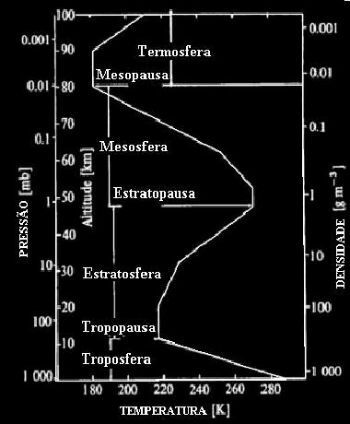
Atmospheric profile showing variations in temperature, pressure and density as a function of altitude.
Composition of the Atmosphere
The Earth's atmosphere is basically composed of nitrogen, oxygen, argon, carbon dioxide and a small amount of other gases. It also has a variable amount of water vapor.
Nitrogen is the most abundant gas in the atmosphere, representing about 78% of its volume. It is an inert gas, that is, it is not used by our body's cells.
The air we breathe is about 20% oxygen, which is the essential gas for living things.
carbon dioxide (CO2) is essential for photosynthesis. Furthermore, it is an efficient long-wave energy absorber, which causes the lower layers of the atmosphere to retain heat.
Water vapor is one of the gases that has the most varied amounts in the atmosphere. It may represent, in some regions, 4% of its volume. It is essential for the distribution of water on the planet, since in its absence there are no clouds, rain or snow.
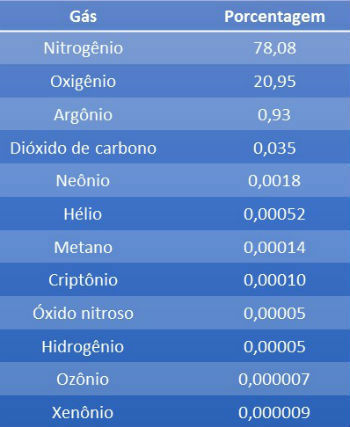
Composition of the atmosphere considering dry air, ie without water vapor.
Know more: air composition
Primitive Atmosphere
By comparing the atmospheres of other planets, it is believed that the Earth's primitive atmosphere was composed of hydrogen, methane, ammonia and water vapor.
These gases would have undergone chemical reactions, by the action of solar radiation and electrical discharges. Gradually originating the current composition of the atmosphere.
General Circulation of the Atmosphere
Due to the shape of the Earth, there are differences in the heating of the Earth's atmosphere.
To balance this uneven heating, we verified the occurrence of air circulation cells, from the equator to the poles and from the poles to the equator.
In simple terms, we can represent the general circulation of the atmosphere by three cells in each hemisphere.
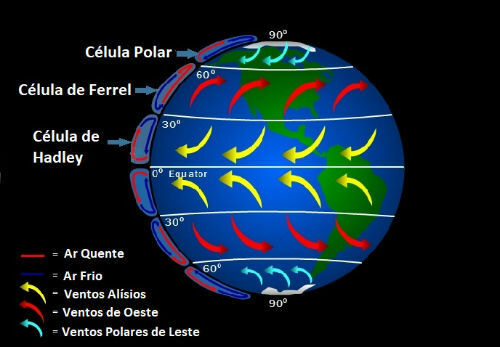
Simplified representation of the general circulation of the atmosphere.
Air pollution
it is considered air pollution, any addition of particles, gaseous compounds and forms of energy (heat, radiation or noise) that are not normally present in the atmosphere.
Air pollution can be the result of natural or man-made processes.
By natural processes we can mention:
- Volcanic eruptions
- sandstorms
- forest fires
- Pollen
- fungus spores
- Cosmic dust
Examples of sources of human pollution are:
- Auto-vehicles
- industrial activities
- thermal power stations
- oil refineries
- Agriculture
- burns
Consequences of air pollution
Air pollution causes negative impacts on human health, the climate and the environment.
One of the effects of the excess of gases emitted by man into the atmosphere is the intensification of the greenhouse effect and the consequent global warming.
The greenhouse effect is a natural and essential phenomenon for living beings. It prevents the Earth from losing too much heat, causing sudden changes in temperature.
With the increase in the emission of greenhouse gases, as a result of human activities, there is an increase in global temperature.
Another consequence of pollution is acid rain, which affects different regions of the planet. The gases and particles that form acid rain can be transported miles away from the emitting source.
How does the Atmosphere protect the Earth?
The atmosphere prevents most meteors that approach the Earth from reaching its surface. Many burn from the friction and heat of the atmosphere.
Ultraviolet radiation is filtered into the ozone layer. This radiation is extremely harmful to living beings.
Furthermore, the atmosphere still regulates the amount of radiation that arrives and is lost by the Earth's surface. This prevents the planet from having a very large temperature variation.
To learn more, read also:
- Atmosphere layers
- Atmosphere of the Planets
- Electromagnetic waves


